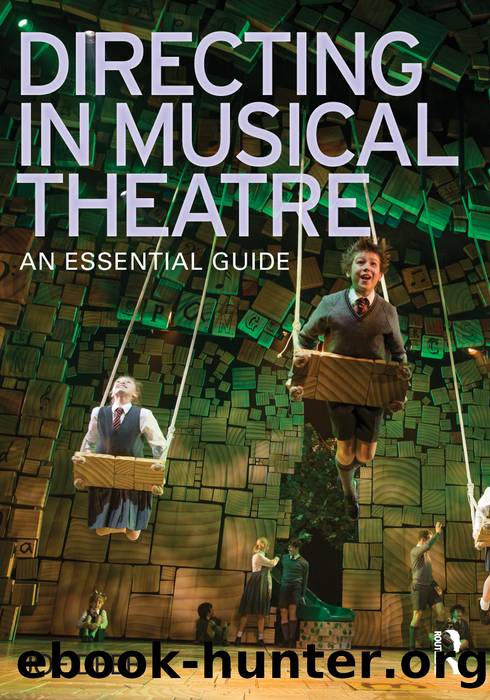Directing in Musical Theatre by Deer Joe;

Author:Deer, Joe;
Language: eng
Format: epub
Publisher: Taylor & Francis Group
Published: 2014-01-15T00:00:00+00:00
UNIT 6.1.2 Staging questions
Staging musical scenes is not primarily an ornamental process (though the staging might eventually be very attractive). Aesthetic choices are the result of a well-articulated storytelling impulse, an inquiry into the human experience of the scene or song, and an awareness of its tone and style. To that end, directors begin to determine staging by asking a series of simple and revealing questions:
Questionnaire: staging action
1. What is the dramatic action of the scene or song? When we use the term âaction,â we mean what the characters do to each other and themselves as a result of their goals, the obstacles they encounter (from others and within themselves) and the actions of those around them. The physics of good drama tells us that when one character takes action, other characters are affected by it and respond in ways that have their own repercussions. Thatâs what makes the world go round in all drama. Since musical staging is just part of the series of dramatic events unfolding in a musical drama, that staging is going to be filled with action: characters doing things to themselves and others. Youâve already answered this question in Unit 1.5. Go back to that scene/song analysis now, as youâll apply it to staging choices as we move forward.
2. How can I express the dramatic action through the charactersâ physical behavior? Your job, and that of your actors, is to express a cohesive version of the story in ways that are evident to your audience. As obvious as this may sound, it bears repeating, because we must not only suspect the action but see and hear it take place through staging and vocal performance choices. This is not to suggest that you have actors inauthentically indicate feelings. We are amplifying truthful behavior to meet the scale that a moment, and a theatrical space, require.
3. How do I express this action while living in the stylistic world of my show? Once youâve understood the internal action of a scene or song, you must express it so it seems to live in the world of your musical. If your musical world is gritty and violent, you probably wonât invoke old-fashioned musical comedy staging traditions (unless the writers have done so ironically, as with âGee, Officer Krupkeâ in West Side Story). Youâll typically match the worldview of your story to the staging tools you employ. This will help determine the degree of pure performance you encourage, the formality of movement and the general visual and acting aesthetic you adopt. That all adds up to style, which we addressed in Unit 1.7. You may wish to revisit the questionnaires on âDefining worldviewâ (p. 34) and âElements of styleâ (p. 36).
4. How can I express this dramatic action in a way that is aesthetically pleasing? All things being equal, we are seeking to transcend merely prosaic and functional staging to achieve something that is entertaining, visually and aurally pleasant, and artistically satisfying. How we define âpleasantâ and âsatisfyingâ has everything to do with the rules of the theatrical world weâre creating.
Download
This site does not store any files on its server. We only index and link to content provided by other sites. Please contact the content providers to delete copyright contents if any and email us, we'll remove relevant links or contents immediately.
Phoenicians among Others: Why Migrants Mattered in the Ancient Mediterranean by Denise Demetriou(564)
Verus Israel: Study of the Relations Between Christians and Jews in the Roman Empire, AD 135-425 by Marcel Simon(563)
Caesar Rules: The Emperor in the Changing Roman World (c. 50 BC â AD 565) by Olivier Hekster(543)
Europe, Strategy and Armed Forces by Sven Biscop Jo Coelmont(487)
Banned in the U.S.A. : A Reference Guide to Book Censorship in Schools and Public Libraries by Herbert N. Foerstel(458)
Give Me Liberty, Seventh Edition by Foner Eric & DuVal Kathleen & McGirr Lisa(457)
american english file 1 student book 3rd edition by Unknown(448)
Reading Colonial Japan by Mason Michele;Lee Helen;(447)
The Roman World 44 BC-AD 180 by Martin Goodman(445)
DS001-THE MAN OF BRONZE by J.R.A(432)
The Dangerous Life and Ideas of Diogenes the Cynic by Jean-Manuel Roubineau(424)
Basic japanese A grammar and workbook by Unknown(421)
The Oxford History of World War II by Richard Overy(420)
Imperial Rome AD 193 - 284 by Ando Clifford(419)
Introducing Christian Ethics by Samuel Wells and Ben Quash with Rebekah Eklund(419)
Literary Mathematics by Michael Gavin;(379)
Language Hacking Mandarin by Benny Lewis & Dr. Licheng Gu(356)
How to Reach the 9.0 in IELTS Academic Reading by IELTS Medical(340)
The Oxford History of the Renaissance by Campbell Gordon;(337)
